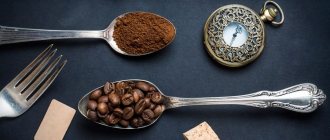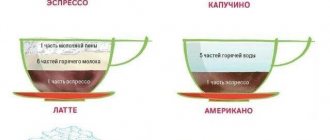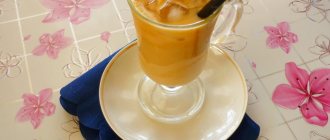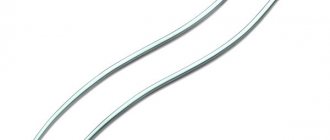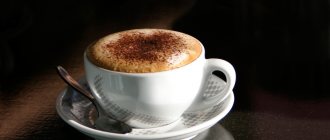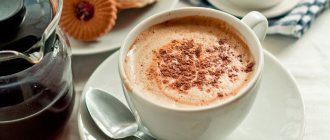Author: Yulia Sabinova. Updated 04/29/2017
When preparing many dishes, drinks and desserts, you may need to measure a certain amount of milk in grams or milliliters, so many may find it helpful to do this without a scale using a regular glass. Let's consider how much milk is contained in a faceted glass in grams and milliliters, as well as its calorie content in such a volume.
What else do you need to know when preparing dairy dishes?
- The densities of regular and skim milk are different, therefore they have different weights, which, however, is not important for most recipes that are prepared at home.
- 103 grams is a value close to 100, so when preparing dishes at home, when accuracy is not so important, the difference of 3 grams is not taken into account, and the amount of milk is rounded down. Thus, knowing how many grams are in 100 ml of milk is not something that is vital for cooking every day.
- You can use a measuring cup to measure the volume of milk - this will greatly facilitate the cooking process.
- If for some reason there is more milk in the dough than stated in the recipe, do not despair! Liquid foods can be balanced by adding flour or simply increasing all other ingredients. The dish will turn out a little larger than planned, but this is not a reason to be upset.
Prepare your favorite dishes using the correct proportions.
Measure, measure milk in glasses in milliliters (measuring table)
| Milk quantity | Number of glasses |
| 1 l. milk is | 4 full cut glasses of milk (250 ml.) |
| 900 ml. milk is | 2 full glasses of milk, filled to the rim + 2 glasses of milk, filled to the rim |
| 800 ml. milk is | 4 cut glasses of milk, filled according to risk |
| 750 ml. milk is | 3 full faceted glasses of milk |
| 700 ml. milk is | 3.5 glasses of milk, filled at risk |
| 600 ml. milk is | 3 glasses of milk, filled according to risk |
| 500 ml. milk is | 2 full faceted glasses of milk |
| 400 ml. milk is | 2 glasses of milk, filled according to risk |
| 300 ml. milk is | 1.5 cups milk, filled at risk |
| 250 ml. milk is | 1 full faceted glass of milk |
| 200 ml. milk is | 1 faceted glass of milk, filled according to risk |
| 150 ml. milk is | About a little less than 2/3 cup milk |
| 100 ml. milk is | 0.5 cups of milk, filled to the brim |
| 50 ml. milk is | 1/5 cup milk |
We hope that our article helped you and we answered your question. If you liked our site, please add it to your browser bookmarks and share the site with your friends on social networks. In this way you will help our project.
Source
Liquids
Liquids are almost always measured in milliliters, which makes cooking much easier since it is enough to know the volume of the container in which food is usually measured. When prescription liquids are measured in grams, their weight is as close as possible to the volume.
| Liquid product | Product weight in grams | ||||||
| Tea room (5 ml) | Dessert l. (10 ml) | Dining room l. (15 ml) | 200 ml | 250 ml | 500 ml | 1000 ml | |
| Water | 5 | 10 | 15 | 200 | 250 | 500 | 1000 |
| Milk | |||||||
| Cream | |||||||
| Liquor | |||||||
| Cognac | |||||||
| Vinegar | |||||||
| Ghee | 7 | 14 | 20 | 195 | 240 | 480 | 960 |
| Rendered fat | 5 | 10 | 15 | 195 | 240 | 480 | 960 |
| Sunflower olive oil | 6 | 12 | 18 | 185 | 230 | 460 | 920 |
| Melted margarine | 5 | 10 | 15 | 180 | 225 | 450 | 900 |
Weight and volume in a faceted glass (ml, g)
How many ml in a glass? Volume of a faceted glass
– If you fill the glass to the rim , the volume of the product will be 200 ml . – If you fill it to the top , the volume will be 250 ml .
How many grams are in a glass?
Different foods have different weights: water, flour, sugar, salt, etc. - You can measure the weight of these and other products using the table.
How many grams of water are in a glass?
If you pour it to the rim, you get 200 grams of water. If you fill it to the top, there will be 250 g of water.
How much does an empty glass weigh?
An ordinary faceted glass (empty) weighs 220-230 g. The weight of other glasses can be from 170 to 250 grams.
How to measure the right amount of milk using glasses?
However, to understand all the recipes, it is not enough to know only that 100 ml contains 103 grams of milk. If a person gets used to measuring milk exclusively in milliliters and grams, sooner or later one of the recipes will pose the following question to him: 100 grams of milk - how much is it in glasses?
Do not be afraid of the problem that has arisen, since it is quite easy to solve. To convert grams to glasses, you need to know that one thin glass holds 250 grams of milk. Thus, 100 grams of milk is 2/5 of such a glass. If we take a faceted glass as a unit of measurement, into which you can pour 200 grams of the desired liquid, then 100 grams of milk will then be exactly half a glass.
How many grams and ml. milk in a glass
It is convenient to measure the weight of milk with glasses if you need to measure a large amount of milk. But you don’t have a measuring cup or beaker available. But there are situations when you need to measure out a small amount of milk. For this we recommend using a tablespoon and a teaspoon. You can read information on this method in our article on how much milk is in a spoon.
| Name of the glass | Weight in grams | Volume in ml. |
| In a cut glass (filled to the rim) | 250 grams of milk | 250 ml. milk |
| In a cut glass (filled to the brim) | 200 grams of milk | 200 ml. milk |
| In a glass of 250 milliliters | 250 grams of milk | 250 ml. milk |
| A glass of milk contains 200 ml. | 200 grams of milk | 200 ml. milk |
250 grams of milk = 250 milliliters of milk
200 grams of milk = 200 milliliters of milk
Very often in the kitchen you have to measure food. It's good to have measuring scales. What to do if the battery in the measuring scales is not there or is dead? We bring to your attention a measuring table for food products, designed specifically to use ordinary cutlery to measure the weight you need according to the recipe. To better understand volume measurements, visit our liquid measurement chart.
How to convert milliliters to grams?
One of the most necessary skills in the kitchen is converting milliliters to grams. Grams are a unit of mass that depends on the density and volume of the liquid being measured. If we are talking about water, then 100 ml of water will equal 100 g, since the density of water is approximately equal to 1.
In order to convert milliliters of milk into grams, you need to know that its density is on average 1.03. Using the formula, you can determine how many grams of milk are in 100 ml. This is not so difficult: you need to multiply the volume of the product by its density and get the result. In this case, the result will be a value equal to 103 g. Thus, the problem of how many grams of milk are in 100 ml is already a resolved issue.
Calorie content of kefir
These indicators are required by nutritionists, as well as those who monitor their diet and adhere to a healthy diet and balanced diet. The calorie content of kefir depends on its fat content. So, in a faceted glass, filled according to risk, 200 ml of kefir are placed, the calorie content of which is 80 kilocalories. Provided that it is a product with 1% fat content. The same volume of kefir with 2.5% fat content in a glass will be 100 kilocalories. Now you know how many glasses it is - 500 ml of kefir, and you can determine the calorie content of the required volume of the product. So, for 500 ml of a product with 1% fat content, the calorie content will be 200 kilocalories, and for 2.5% - 250 kilocalories.
What units of measurement exist in cooking?
In culinary recipes, ingredients are most often measured in milliliters, grams and cups. How do these three units of measurement differ? The fact is that the amount of solid products, for example, oil, is usually indicated in grams. Milliliters are a measure of liquids: water, milk. Glasses are used both for measuring liquids and bulk products - flour, cereals.
Is this unspoken distinction always respected? For the most part, yes, but the fact that some recipes may indicate the amount of liquids in grams and dry solids in milliliters should not be an obstacle to preparing the desired dish. Therefore, the ability to convert milliliters into grams or glasses and vice versa, quickly and correctly, is the key to success for every housewife.
Products with viscous consistency
Let's consider the last type of product.
| Product name | Measures of weight in grams | ||||||
| Spoon | Cup | 0.5 liter jar | 1 liter jar | ||||
| tea room | dessert | dining room | 200 ml | 250 ml | |||
| Boiled condensed milk | 12 | 25 | 40 | 280 | 350 | 700 | 1400 |
| Berry/fruit puree | 12 | 25 | 40 | 280 | 350 | 700 | 1400 |
| Jam/Jam | 15 | 30 | 45 | 275 | 340 | 675 | 1350 |
| Honey | 12 | 25 | 40 | 260 | 325 | 650 | 1300 |
| Condensed milk | 12 | 22 | 35 | 240 | 300 | 600 | 1200 |
| Tomato paste | |||||||
| Sour cream | 10 | 20 | 30 | 210 | 265 | 530 | 1060 |
| Mayonnaise | 8 | 15 | 25 | 200 | 250 | 500 | 1000 |
Spices and additives (ground)
Since the preparation of most dishes requires little spice, the main measurements are teaspoons and tablespoons. For convenience, a dessert spoon was added, the standard volume of which is 10 ml. Weights of food in spoons are not equivalent to their volume.
The weight of most spices and additives depends on the grind and quality of the product. For example, coarsely ground coffee will weigh slightly more than finely ground coffee.
Note:
- The table of weights and measures of products in grams does not guarantee an absolutely accurate weight, since the consistency and size of many products are not always the same.
- Very often, spices are measured in pinches; one pinch contains about a quarter of a teaspoon.
| Product | Product weight | |||
| Tea spoon | Dessert spoon | Tablespoon | ||
| Baking soda | 12 | 24 | 45 | |
| Starch | 10 | 20 | 30 | |
| Powdered sugar | ||||
| Lemon acid | 8 | 15 | 25 | |
| Baking powder | ||||
| Cocoa | ||||
| Cinnamon | 7 | 13 | 20 | |
| Ground coffee | ||||
| Poppy | 6 | 12 | 18 | |
| Gelatin | 5 | 10 | 15 | |
| Pepper | ||||
| Breadcrumbs | ||||
| Mustard | 4 | 8 | 12 | |
| Instant coffee | 3 | 6 | 10 | |
| Carnation | ||||
Bulk products
This type includes cereals, sugar, salt, flour and some others. The table for measuring the weight of bulk products offers the main methods of measurement - a spoon and a glass, dividing them into several types, according to volume. For the convenience of preparing large portions, half-liter and liter jars were added.
Always read the recipe carefully - one cup of flour does not mean 200g of flour, even if your cup is slightly larger than 200ml. Remember that in a “Stalinist” tea glass, filled to the brim, there is only 160 g of flour.
Note: If you don’t have a traditional cut glass on hand in your kitchen, you can replace it with a plastic one. A standard transparent disposable polypropylene glass holds exactly 200 ml of water.
| Product name | Measures of weight in grams | ||||||
| Spoon | Cup | 0.5 liter jar | 1 liter jar | ||||
| tea room | dessert | dining room | 200 ml | 250 ml | |||
| Salt | 13 | 25 | 40 | 255 | 320 | 640 | 1280 |
| Bulgur | 8 | 15 | 25 | 190 | 235 | 470 | 940 |
| Peas | 8 | 15 | 25 | 185 | 230 | 460 | 920 |
| Pearl barley | |||||||
| Rice | |||||||
| Couscous | 8 | 15 | 25 | 180 | 225 | 450 | 900 |
| Millet | 8 | 15 | 25 | 175 | 220 | 440 | 880 |
| Buckwheat | 7 | 15 | 25 | 165 | 210 | 420 | 840 |
| Sugar | 10 | 20 | 30 | 160 | 200 | 400 | 800 |
| Semolina | 8 | 15 | 25 | ||||
| Corn flour | 10 | 20 | 30 | 145 | 180 | 360 | 720 |
| Wheat groats | |||||||
| Barley groats | |||||||
| Wheat flour | 8 | 15 | 25 | 130 | 160 | 320 | 640 |
| Powdered milk | 4 | 8 | 15 | 100 | 120 | 240 | 480 |
| Oat flakes | 5 | 10 | 15 | 80 | 100 | 200 | 400 |
| Hercules | 4 | 9 | 15 | 60 | 75 | 150 | 300 |
| Cornflakes | 3 | 6 | 10 | 50 | 60 | 125 | 250 |
Dinner plate
What should a housewife do when there are no spoons or glasses at hand, but there is an ordinary soup plate? The answer suggests itself. The available liquid can be measured in a plate. So, 200 ml - how many dinner plates is that?
To answer the question posed, you must first find out how much one plate of a particular liquid holds. So, 500 units of water, milk or vinegar are placed in a soup dish. This means that no matter what liquid you need, its volume will be the same.
In order to get 200 milliliters of water, you need to take a little less than half of the measuring container you are using.
The same is true with milk. To obtain the volume in question, you will need less than half a plate filled with milk.
Vinegar is measured similarly to the first two methods. To get 200 milliliters of vinegar or essence, you will need less than half a plate of this liquid.

